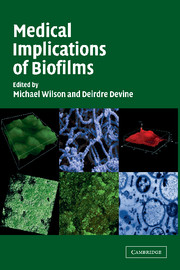Book contents
- Frontmatter
- Contents
- Preface
- List of Contributors
- PART ONE INTRODUCTORY CHAPTERS
- 1 Biofilm-Dependent Regulation of Gene Expression
- 2 Quorum Sensing and Microbial Biofilms
- 3 Antimicrobial Agents and Biofilms
- PART TWO BIOFILMS ON PROSTHETIC DEVICES
- PART THREE ORAL BIOFILMS
- PART FOUR BIOFILMS ON SHEDDING SURFACES
- Index
- References
1 - Biofilm-Dependent Regulation of Gene Expression
Published online by Cambridge University Press: 23 November 2009
- Frontmatter
- Contents
- Preface
- List of Contributors
- PART ONE INTRODUCTORY CHAPTERS
- 1 Biofilm-Dependent Regulation of Gene Expression
- 2 Quorum Sensing and Microbial Biofilms
- 3 Antimicrobial Agents and Biofilms
- PART TWO BIOFILMS ON PROSTHETIC DEVICES
- PART THREE ORAL BIOFILMS
- PART FOUR BIOFILMS ON SHEDDING SURFACES
- Index
- References
Summary
INTRODUCTION
Microbial development and biofilm formation on implanted biomaterials and hospital equipment are important sources of nosocomial infections, mainly because surface-associated contaminants express biofilm-specific properties such as increased resistance to biocides, antibiotics, and immunological defences. Although it has long been recognised that the presence of a solid phase can influence many bacterial functions (ZoBell, 1943; Costerton et al., 1987; Van Loosdrecht et al., 1990), we are just beginning to understand the regulatory processes at the molecular level. There is no doubt that the identification of the structures involved in the sensing of the particular microenvironments encountered at interfaces and in developing biofilms and the description of the regulatory networks allowing the appropriate genetic responses will lead to the development of surface coatings and preventive or curative drugs able to deal with these life-threatening infections.
BIOFILM FORMATION IS A DEVELOPMENTAL PROCESS
An invidual bacterium present on, or introduced into, the human body can reach the surface of an indwelling medical device by three different mechanisms (Van Loosdrecht et al., 1990): passive transport due to air or liquid flow, diffusive transport resulting from Brownian motion, and active movement involving flagella. Although contact is, therefore, frequently a question of chance, chemotactic processes can direct motile bacteria in response to any concentration gradient that may exist in the interfacial region. Following contact, the next stage may be initial adhesion.
- Type
- Chapter
- Information
- Medical Implications of Biofilms , pp. 3 - 17Publisher: Cambridge University PressPrint publication year: 2003
References
- 1
- Cited by



